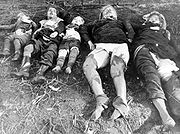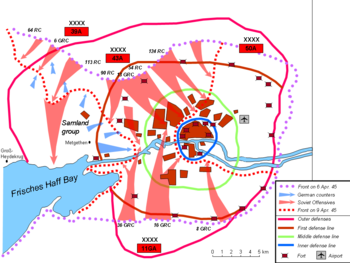
Metgethen massacre
Encyclopedia

East Prussia
East Prussia is the main part of the region of Prussia along the southeastern Baltic Coast from the 13th century to the end of World War II in May 1945. From 1772–1829 and 1878–1945, the Province of East Prussia was part of the German state of Prussia. The capital city was Königsberg.East Prussia...
(today's Aleksandra Kosmodemyanskogo
Aleksandra Kosmodemyanskogo
Imeni Alexandra Kosmodemyanskogo is a rural locality under the jurisdiction of Oktyabrsky City District of the city of Kaliningrad, Kaliningrad Oblast, Russia, and, municipally, a part of Kaliningrad Urban Okrug....
, formerly Lesnoy, Kaliningrad Oblast, Russia), located a few kilometers to the west of Königsberg
Königsberg
Königsberg was the capital of East Prussia from the Late Middle Ages until 1945 as well as the northernmost and easternmost German city with 286,666 inhabitants . Due to the multicultural society in and around the city, there are several local names for it...
, was a German village which fell to the advancing Red Army
Red Army
The Workers' and Peasants' Red Army started out as the Soviet Union's revolutionary communist combat groups during the Russian Civil War of 1918-1922. It grew into the national army of the Soviet Union. By the 1930s the Red Army was among the largest armies in history.The "Red Army" name refers to...
in January, 1945.
Timeline

Battle of Königsberg
The Battle of Königsberg , was one of the last operations of the East Prussian Offensive during World War II. In four days of violent urban warfare, Soviet forces of the 1st Baltic Front and the 3rd Belorussian Front captured the city of Königsberg...
in 1945, Soviet forces attacking from the north of the Samland peninsula reached the Vistula Lagoon
Vistula Lagoon
The Vistula Lagoon is a fresh water lagoon on the Baltic Sea separated from Gdańsk Bay by the Vistula Spit. It is sometimes known as the Vistula Bay or Vistula Gulf. The modern German name, Frisches Haff, is derived from an earlier form, Friesisches Haff. Both this term and the earlier Polish...
to the west of Königsberg on January 30, taking Metgethen in the process, a village with a railway station. After dark, they further advanced westward to Groß-Heydekrug.
German forces recaptured Metgethen on February 19 in a successful bid to reopen the vital road and railway line between the besieged Königsberg and the Baltic Sea
Baltic Sea
The Baltic Sea is a brackish mediterranean sea located in Northern Europe, from 53°N to 66°N latitude and from 20°E to 26°E longitude. It is bounded by the Scandinavian Peninsula, the mainland of Europe, and the Danish islands. It drains into the Kattegat by way of the Øresund, the Great Belt and...
harbor of Pillau. According to German reports, mutilated corpses of civilians were discovered. The news was quickly spread by German propaganda.
The German findings
There are several contemporary reports by German military personnel stating that, among other things, women had been raped, mutilated, and killed, and that 32 civilians had been rounded up on the local tennis court and killed by an explosion. In one of the eyewitness reports, Captain Hermann Sommer, former staff officer of the fortress commander of Königsberg, stated:
Translation: I made my own observations on February 27th, 1945, when I came to Metgethen on official business. When I drove my motorcycle just before the railway-crossing into a gravel-pit, in order to inspect the building there for its usability, I found behind it the corpses of twelve women and six children. All were completely undressed and huddled up in a pile. Most of the children had had their skulls broken with a blunt object or their tiny bodies perforated with innumerable bayonet stabs. The women, mostly older ones between forty and sixty years, had also been killed with knives or bayonets. On all of them black-and-blue marks of beating were clearly visible.
The Library of Congress
Library of Congress
The Library of Congress is the research library of the United States Congress, de facto national library of the United States, and the oldest federal cultural institution in the United States. Located in three buildings in Washington, D.C., it is the largest library in the world by shelf space and...
possesses an album of 26 mounted photographs, with the cover title "Bildbericht über von den Bolschewisten ermordete und geschändete Deutsche in Metgethen" (Picture report about the Germans murdered and desecrated by Bolshevists at Metgethen). According to an ink stamp on its cover, this album had once been filed in the office of the commander of the Sicherheitspolizei
Sicherheitspolizei
The Sicherheitspolizei , often abbreviated as SiPo, was a term used in Nazi Germany to describe the state political and criminal investigation security agencies. It was made up by the combined forces of the Gestapo and the Kripo between 1936 and 1939...
at Königsberg.
Further reading
- Michael Klonovsky: Preußen zahlt die Zeche: Article formerly published in FocusFocus (German magazine)Focus is a German weekly news magazine published in Munich and distributed throughout Germany. It is the third-largest weekly news magazine in Germany. It is considered conservative and leaned towards economic liberalism.- Overview :...
, 07/2005, p. 72-76 (German), quoting contemporary reports by Karl August Knorr and Hermann Sommer

